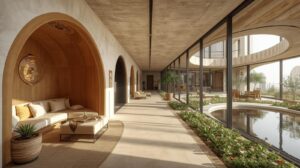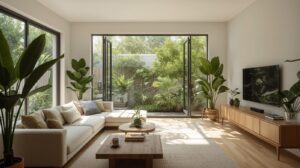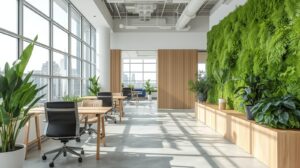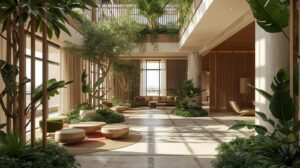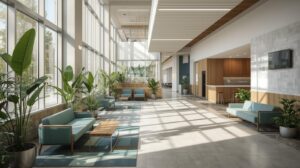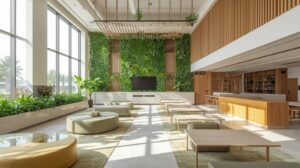In today’s fast-paced, urbanized world, interior spaces have become more than just functional areas—they are sanctuaries where we seek comfort, inspiration, and a sense of well-being. One design philosophy that perfectly aligns with this human need is biophilic interior design. Rooted in the concept of biophilia, which translates to “love of life” or “connection with nature,” this approach integrates natural elements into interiors, creating spaces that nurture both body and mind.
If you’ve been looking to revamp your home or office with nature-inspired interiors, understanding biophilic design principles is essential. In this guide, we explore everything about biophilic interior design, its benefits, practical applications, and strategies to seamlessly incorporate nature into modern interiors.
What is Biophilic Interior Design?
Biophilic interior design is a method of shaping interior spaces that prioritizes human-nature connections. Unlike simply decorating with plants, it is a holistic design strategy that combines natural materials, patterns, lighting, and spatial organization to recreate the calming and restorative effects of nature indoors.
The concept originates from biologist Edward O. Wilson, who suggested that humans have an innate tendency to connect with natural environments—a trait called biophilia. Modern interiors that embrace this concept not only look visually appealing but also enhance mental clarity, reduce stress, and promote well-being.
Core Principles of Biophilic Design
Biophilic interiors can be approached through three main principles:
1. Direct Connection with Nature
This principle emphasizes incorporating tangible elements from the natural world:
- Indoor Greenery: Plants, vertical gardens, and potted arrangements purify air, add color, and provide a sense of calm.
- Natural Light: Maximizing daylight through large windows or skylights improves mood and energy levels.
- Water Features: Fountains, aquariums, or even small tabletop water installations replicate soothing natural sounds.
- Natural Materials: Wood, stone, bamboo, and rattan give interiors a tactile and visual connection with the outdoors.
2. Indirect Connection with Nature
When direct natural elements aren’t possible, indirect connections can evoke similar feelings:
- Nature-Inspired Patterns: Organic motifs, leaf designs, and fractal patterns in furniture, wallpaper, or rugs.
- Earthy Color Palettes: Shades of green, brown, beige, and blue mimic natural environments.
- Art and Imagery: Nature-themed paintings, murals, or photographs can bring the outdoors inside.
- Natural Sounds and Aromas: Playing soft ambient nature sounds or using natural scents enhances sensory connection.
3. Spatial and Environmental Design
The layout and spatial experience play a vital role in creating biophilic interiors:
- Refuge Spaces: Cozy nooks and corners offer comfort and security, mimicking natural shelters.
- Prospect Spaces: Open layouts with clear sightlines replicate expansive natural environments.
- Organic Flow: Curved pathways and open spaces emulate exploration in nature.
- Indoor-Outdoor Continuity: Balconies, terraces, and large windows blur the boundary between inside and outside.
Why Biophilic Interior Design Matters
The benefits of incorporating biophilic design into interiors extend beyond aesthetics. Scientific studies show it positively impacts health, productivity, and overall well-being.
1. Boosts Mental Health
Being surrounded by nature-inspired elements reduces stress, anxiety, and fatigue, creating interiors that feel peaceful and restorative.
2. Enhances Productivity and Creativity
Workspaces with natural light, indoor plants, and organic forms increase focus, creativity, and engagement, making biophilic offices highly sought after.
3. Supports Physical Health
Proper ventilation, natural light, and greenery improve air quality, circadian rhythm, and physical comfort, promoting a healthier indoor environment.
4. Strengthens Connection with Space
People naturally feel more connected and grounded in interiors that reflect nature, fostering a sense of belonging and emotional well-being.
5. Encourages Sustainability
Using natural, renewable materials and integrating plants into interiors encourages eco-conscious living while reducing environmental impact.
Key Elements of Biophilic Interior Design
To successfully design a biophilic home or office, focus on these essential elements:
Light and Daylight
- Maximize natural light with large windows, skylights, and glass partitions.
- Use reflective surfaces to enhance daylight distribution.
- Incorporate dynamic lighting that mimics natural day-night cycles.
Air Quality
- Ensure ventilation and airflow to replicate fresh outdoor air.
- Introduce air-purifying plants to naturally filter indoor pollutants.
Water and Sound
- Add indoor fountains or aquariums to create a calming soundscape.
- Use water-inspired designs in textures and patterns for visual tranquility.
Natural Materials and Textures
- Choose wood, stone, bamboo, wool, or cork for furniture, flooring, and walls.
- Use textiles and finishes that provide tactile comfort while evoking nature.
Greenery
- Integrate vertical gardens, hanging plants, or indoor shrubs.
- Select low-maintenance plants suitable for indoor conditions.
Views and Vistas
- Frame outdoor landscapes with strategic window placement.
- Design interiors with open sightlines and transparent partitions to maintain visual access to greenery.
Practical Applications of Biophilic Interior Design
Biophilic design can transform any interior, from homes to offices and commercial spaces:
1. Residential Spaces
- Living Rooms: Add vertical gardens, natural wood furniture, and daylight exposure.
- Bedrooms: Use earth-toned textiles, soft textures, and indoor plants for relaxation.
- Kitchens: Integrate herbs, greenery, and natural stone surfaces.
2. Office Spaces
- Open Offices: Green walls, natural lighting, and curved layouts enhance focus.
- Meeting Rooms: Incorporate plants, water features, and natural textures to reduce stress.
- Break Areas: Use calming biophilic elements for restorative spaces.
3. Hospitality
- Hotels: Lobbies with living walls, guest rooms with wooden textures, and terraces with plants create a luxurious nature-connected experience.
- Restaurants: Greenery, daylight, and water elements improve ambiance and customer satisfaction.
4. Healthcare
- Hospitals and Clinics: Natural light, plant-filled waiting areas, and calming interiors reduce stress and support faster recovery.
5. Educational Spaces
- Classrooms and libraries benefit from plants, daylight, and organic layouts, improving focus and learning outcomes.
Tips for Implementing Biophilic Interiors
- Incorporate Vertical Greenery: Use walls for plant installations to save space and improve air quality.
- Use Nature-Inspired Patterns: Integrate organic textures and shapes into furniture, walls, and decor.
- Maximize Daylight: Position workstations and living areas near windows or skylights.
- Create Seamless Indoor-Outdoor Spaces: Open terraces, balconies, and glass doors enhance the connection with nature.
- Integrate Natural Sounds and Scents: Fountains, wind chimes, or nature-inspired audio can evoke a calming environment.
- Prioritize Sustainable Materials: Use eco-friendly wood, stone, and natural fabrics for furniture and finishes.
- Design Relaxation Zones: Include cozy corners or reading nooks with plants and natural textures.
Challenges of Biophilic Design
- Space Limitations: Small urban homes may struggle to integrate large greenery.
- Maintenance Needs: Plants, water features, and natural materials require regular care.
- Budget Constraints: Quality natural materials and innovative biophilic elements may increase costs.
- Climate Considerations: Plant selection and water-based installations need careful planning depending on the environment.
Despite these challenges, creative solutions such as low-maintenance plants, modular green walls, and eco-friendly synthetic alternatives make biophilic interiors achievable for almost any space.
Read more on How Long Do Interiors Usually Take? Realistic Timelines Explained
The Future of Biophilic Interior Design
As urban living continues to dominate, the need for nature-connected interiors grows stronger. Smart home technologies can further enhance biophilic design by:
- Adjusting lighting to mimic natural daylight cycles
- Monitoring plant health and indoor air quality
- Creating interactive green walls or indoor gardens
With growing awareness of sustainability, wellness, and mental health, biophilic interior design is not just a trend—it’s the future of modern, human-centered architecture.
Conclusion
Biophilic interior design bridges the gap between humans and nature, turning interiors into restorative, inspiring, and healthy environments. Whether it’s a home, office, hotel, or educational space, incorporating natural elements, daylight, greenery, and organic materials elevates well-being, creativity, and comfort.
By embracing biophilic design principles, you are not only creating visually stunning interiors but also nurturing spaces that support physical health, mental clarity, and emotional balance. In the era of urban living, nature-inspired interiors are more than a design choice—they are a lifestyle choice.
Interiofy® can help you bring this lifestyle to life. From concept to execution, we design biophilic spaces that merge elegance with sustainability. Contact us today to transform your home or workspace with the power of nature.
